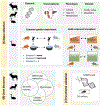Life in Deserts: The Genetic Basis of Mammalian Desert Adaptation
- PMID: 33863602
- PMCID: PMC12090818
- DOI: 10.1016/j.tree.2021.03.007
Life in Deserts: The Genetic Basis of Mammalian Desert Adaptation
Abstract
Deserts are among the harshest environments on Earth. The multiple ages of different deserts and their global distribution provide a unique opportunity to study repeated adaptation at different timescales. Here, we summarize recent genomic research on the genetic mechanisms underlying desert adaptations in mammals. Several studies on different desert mammals show large overlap in functional classes of genes and pathways, consistent with the complexity and variety of phenotypes associated with desert adaptation to water and food scarcity and extreme temperatures. However, studies of desert adaptation are also challenged by a lack of accurate genotype-phenotype-environment maps. We encourage development of systems that facilitate functional analyses, but also acknowledge the need for more studies on a wider variety of desert mammals.
Keywords: adaptation; desert; genomics; mammals; physiology.
Published by Elsevier Ltd.
Conflict of interest statement
Declaration of Interests None declared by authors.
Figures



Similar articles
-
Whole-genome sequencing reveals adaptations of hairy-footed jerboas (Dipus, Dipodidae) to diverse desert environments.BMC Biol. 2023 Aug 30;21(1):182. doi: 10.1186/s12915-023-01680-5. BMC Biol. 2023. PMID: 37649052 Free PMC article.
-
Comparative and population genomics approaches reveal the basis of adaptation to deserts in a small rodent.Mol Ecol. 2020 Apr;29(7):1300-1314. doi: 10.1111/mec.15401. Epub 2020 Mar 23. Mol Ecol. 2020. PMID: 32130752 Free PMC article.
-
Whole-Genome Sequencing of Native Sheep Provides Insights into Rapid Adaptations to Extreme Environments.Mol Biol Evol. 2016 Oct;33(10):2576-92. doi: 10.1093/molbev/msw129. Epub 2016 Jul 8. Mol Biol Evol. 2016. PMID: 27401233 Free PMC article.
-
Physiological adaptations of small mammals to desert ecosystems.Integr Zool. 2009 Dec;4(4):357-66. doi: 10.1111/j.1749-4877.2009.00176.x. Integr Zool. 2009. PMID: 21392308 Review.
-
Developmental and Genetic Aspects of Desert Crops.Annu Rev Genet. 2024 Nov;58(1):91-112. doi: 10.1146/annurev-genet-111523-102338. Annu Rev Genet. 2024. PMID: 39585906 Review.
Cited by
-
Convergent Genomic Signatures of Cashmere Traits: Evidence for Natural and Artificial Selection.Int J Mol Sci. 2023 Jan 6;24(2):1165. doi: 10.3390/ijms24021165. Int J Mol Sci. 2023. PMID: 36674681 Free PMC article.
-
An eco-evo-devo genetic network model of stress response.Hortic Res. 2022 Jun 7;9:uhac135. doi: 10.1093/hr/uhac135. eCollection 2022. Hortic Res. 2022. PMID: 36061617 Free PMC article.
-
Patterns of Genetic Diversity and Gene Flow Associated With an Aridity Gradient in Populations of Common Mole-rats, Cryptomys hottentotus hottentotus.Genome Biol Evol. 2024 Jul 3;16(7):evae144. doi: 10.1093/gbe/evae144. Genome Biol Evol. 2024. PMID: 38953183 Free PMC article.
-
High-Quality Chromosome-Level Genome Assembly of the Corsac Fox (Vulpes corsac) Reveals Adaptation to Semiarid and Harsh Environments.Int J Mol Sci. 2023 May 31;24(11):9599. doi: 10.3390/ijms24119599. Int J Mol Sci. 2023. PMID: 37298549 Free PMC article.
-
Barriers to chimpanzee gene flow at the south-east edge of their distribution.Mol Ecol. 2023 Jul;32(14):3842-3858. doi: 10.1111/mec.16986. Epub 2023 Jun 5. Mol Ecol. 2023. PMID: 37277946 Free PMC article.
References
-
- Ward D. (2016) The Biology of Deserts (2nd edn), Oxford University Press
-
- Willmer P. et al. (2005) Environmental Physiology of Animals (2nd edn), Wiley-Blackwell
-
- Riddell EA et al. (2021) Exposure to climate change drives stability or collapse of desert mammal and bird communities. Science 371, 633–638 - PubMed
Publication types
MeSH terms
Grants and funding
LinkOut - more resources
Full Text Sources
Other Literature Sources

